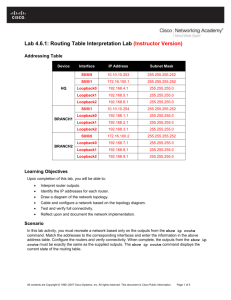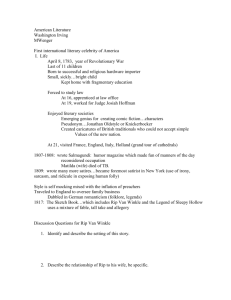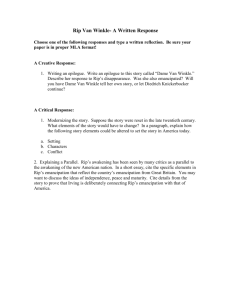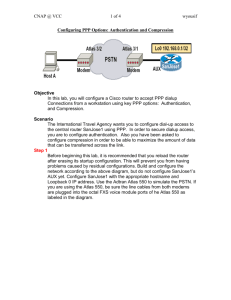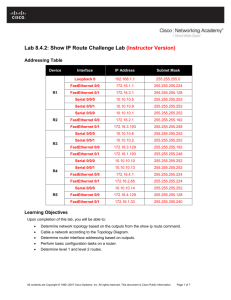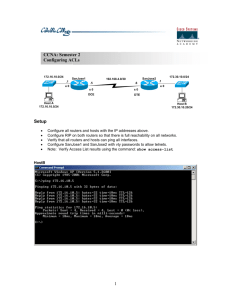Route Rebistribution Lab 2
advertisement
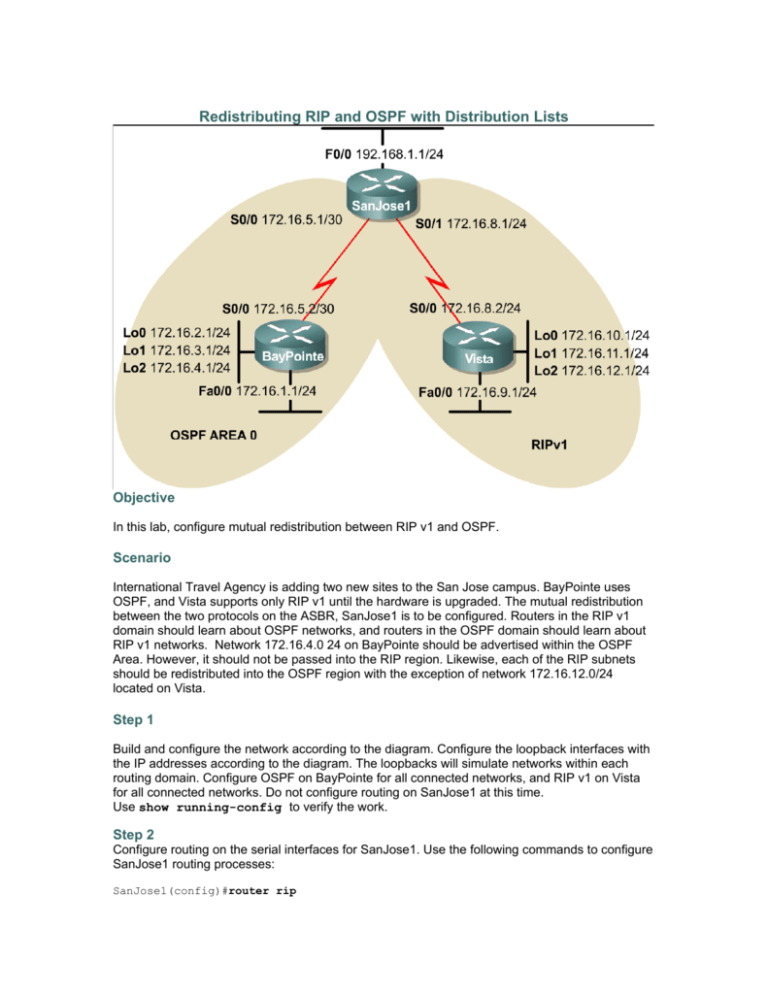
Redistributing RIP and OSPF with Distribution Lists Objective In this lab, configure mutual redistribution between RIP v1 and OSPF. Scenario International Travel Agency is adding two new sites to the San Jose campus. BayPointe uses OSPF, and Vista supports only RIP v1 until the hardware is upgraded. The mutual redistribution between the two protocols on the ASBR, SanJose1 is to be configured. Routers in the RIP v1 domain should learn about OSPF networks, and routers in the OSPF domain should learn about RIP v1 networks. Network 172.16.4.0 24 on BayPointe should be advertised within the OSPF Area. However, it should not be passed into the RIP region. Likewise, each of the RIP subnets should be redistributed into the OSPF region with the exception of network 172.16.12.0/24 located on Vista. Step 1 Build and configure the network according to the diagram. Configure the loopback interfaces with the IP addresses according to the diagram. The loopbacks will simulate networks within each routing domain. Configure OSPF on BayPointe for all connected networks, and RIP v1 on Vista for all connected networks. Do not configure routing on SanJose1 at this time. Use show running-config to verify the work. Step 2 Configure routing on the serial interfaces for SanJose1. Use the following commands to configure SanJose1 routing processes: SanJose1(config)#router rip SanJose1(config-router)#network 172.16.0.0 SanJose1(config-router)#passive-interface serial0/0 SanJose1(config-router)#passive-interface fastethernet0/0 SanJose1(config-router)#router ospf 1 SanJose1(config-router)#network 172.16.5.0 0.0.0.3 area 0 1. Why are the passive interface statements applied to Serial 0/0 and FastEthernet 0/0 in RIP? There are no other RIP hosts on those networks. Periodic RIP updates should be turned off on all RIP enabled interfaces that do not require them. 2. It is not necessary to configure any passive interfaces in the OSPF configuration. Why not? Updates are sent and acknowledged between OSPF neighbors. OSPF does not begin to send multicast hello packets out an interface until a network statement is added to the OSPF configuration that includes or overlaps with the interface IP address. After the routing is configured, check the routing table of SanJose1 as follows: SanJose1#show ip route Gateway of last resort is not set 172.16.0.0/16 is variably subnetted, 10 subnets, 3 masks R 172.16.12.0/24 [120/1] via 172.16.8.2, 00:00:02, Serial0/1 C 172.16.8.0/24 is directly connected, Serial0/1 R 172.16.9.0/24 [120/1] via 172.16.8.2, 00:00:02, Serial0/1 R 172.16.10.0/24 [120/1] via 172.16.8.2, 00:00:02, Serial0/1 R 172.16.11.0/24 [120/1] via 172.16.8.2, 00:00:02, Serial0/1 O 172.16.4.1/32 [110/782] via 172.16.5.2, 00:09:07, Serial0/0 C 172.16.5.0/30 is directly connected, Serial0/0 O 172.16.1.0/24 [110/782] via 172.16.5.2, 00:09:08, Serial0/0 O 172.16.3.1/32 [110/782] via 172.16.5.2, 00:09:08, Serial0/0 O 172.16.2.1/32 [110/782] via 172.16.5.2, 00:09:08, Serial0/0 C 192.168.1.0/24 is directly connected, FastEthernet0/0 SanJose1 should learn about the connected networks of BayPointe by way of OSPF and the connected networks of Vista by way of RIP v1. Troubleshoot, if necessary. The loopbacks advertised on the BayPointe router will be seen by SanJose1 and Vista as /32 networks regardless of the subnetmask assigned to the loopback interface. This is the standard method by which OSPF treats advertised loopback interfaces. Although this occurs regularly in this lab environment, it is not customary to create and advertise loopback networks on a production network. Issue the show ip route command to check the routing table of BayPointe as follows: BayPointe#show ip route Gateway of last resort is not set 172.16.0.0/16 is variably subnetted, 5 C 172.16.4.0/24 is directly connected, C 172.16.5.0/30 is directly connected, C 172.16.1.0/24 is directly connected, C 172.16.2.0/24 is directly connected, C 172.16.3.0/24 is directly connected, subnets, 2 masks Loopback2 Serial0/0 FastEthernet0/0 Loopback0 Loopback1 No dynamically learned routes should be present. Finally, issue the show ip route command to check the routing table of Vista as follows: Vista#show ip route Gateway of last resort is not set 172.16.0.0/24 is subnetted, 5 subnets C C C C C 172.16.12.0 is directly connected, Loopback2 172.16.8.0 is directly connected, Serial0/0 172.16.9.0 is directly connected, FastEthernet0/0 172.16.10.0 is directly connected, Loopback0 172.16.11.0 is directly connected, Loopback1 3. Has Vista learned about any routes by way of RIP v1? Why? Vista is directly connected to all RIP v1 networks, and redistribution has not been configured. Step 3 Configure redistribution on SanJose1 so that all of the OSPF routes except 172.16.4.0/24 are injected into the RIP v1 process. Use the following commands to configure redistribution on SanJose1: SanJose1(config)#router rip SanJose1(config-router)#redistribute ospf 1 SanJose1(config-router)#default-metric 2 4. What is the default-metric command used for? Does it have to be used? 5. Does this accomplish the network design goal? Does this allow for the redistribution of the unintended subnet as well? Consider a route filter policy similar to the previous lab that will allow for the filtering out of the 172.16.4.0 route. Issue the following commands to complete this route filter requirement: SanJose1(config)#access-list 10 deny 172.16.4.0 0.0.0.255 SanJose1(config)#access-list 10 permit any SanJose1(config)#router rip SanJose1(config-router)#distribute-list 10 out s0/1 This completes the filtering. Now the previous commands in step 3 will only redistribute the desired networks. Check the routing table of Vista in the RIP v1 domain as follows: Note: Use the clear ip route * command first. Vista#show ip route Gateway of last resort is not set 172.16.0.0/16 is variably subnetted, 8 subnets, 2 masks C 172.16.12.0/24 is directly connected, Loopback2 C 172.16.8.0/24 is directly connected, Serial0/0 C 172.16.9.0/24 is directly connected, FastEthernet0/0 C 172.16.10.0/24 is directly connected, Loopback0 C 172.16.11.0/24 is directly connected, Loopback1 R 172.16.1.0/24 [120/2] via 172.16.8.1, 00:00:05, Serial0/0 R 172.16.3.1/32 [120/2] via 172.16.8.1, 00:00:05, Serial0/0 R 172.16.2.1/32 [120/2] via 172.16.8.1, 00:00:06, Serial0/0 6. Has Vista learned about any of the networks from the OSPF side? Creating a seed metric can minimize routing loops or black holes in the network. RIP cannot differentiate between internal and external redistributed routes. When a route on a network is redistributed without a default metric, the network appears to be adjacent to the autonomous system. Elevating the external default metric above any internal routes is a crude but effective way of differentiating between internal and external routes. In summary, insure that a metric statement is included at the end of the redistribute command or else identify a default metric value on a separate line. Failure to do so will result in a route being redistributed with an unreachable value. 7. What is the metric for each of these routes? The metric should be two (2). Step 4 Configure redistribution on SanJose1 so that RIP v1 routes are injected into the OSPF process. Use the following commands to configure mutual redistribution on SanJose1: SanJose1(config)#router ospf 1 SanJose1(config-router)#redistribute rip SanJose1(config-router)#default-metric 10 Now include the following necessary commands to filter out the 172.16.12.0/24 network from being advertised: SanJose1(config)#access-list 20 deny 172.16.12.0 0.0.0.255 SanJose1(config)#access-list 20 permit any SanJose1(config)#router ospf 1 SanJose1(config-router)#distribute-list 20 out Notice when applying the distribution list within OSPF the interface option was omitted. OSPF will not allow a distribute list applied in the outbound direction for one particular interface. It must be configured as a global distribute list. RIP does not have this same restriction so the interface and direction was specified in the command syntax in Step 3. Check the routing table of BayPointe in the OSPF domain. BayPointe has not learned about any of the networks from the RIP v1 side. 8. Why has not BayPointe learned about any of the networks from the RIP v1 side? BayPointe should not have any new routes in its routing table. That is because OSPF will not redistribute RIP subnets unless explicitly configured with the subnets keyword. Return to SanJose1 and enter the following configuration: SanJose1(config)#router ospf 1 SanJose1(config-router)#redistribute rip subnets After these commands are entered, check the routing table of BayPointe again as follows: BayPointe#show ip route Gateway of last resort is not set 172.16.0.0/16 is variably subnetted, 9 subnets, 2 masks O E2 172.16.8.0/24 [110/10] via 172.16.5.1, 00:00:10, Serial0/0 O E2 172.16.9.0/24 [110/10] via 172.16.5.1, 00:00:10, Serial0/0 O E2 172.16.10.0/24 [110/10] via 172.16.5.1, 00:00:10, Serial0/0 O E2 172.16.11.0/24 [110/10] via 172.16.5.1, 00:00:10, Serial0/0 C 172.16.4.0/24 is directly connected, Loopback2 C 172.16.5.0/30 is directly connected, Serial0/0 C 172.16.1.0/24 is directly connected, FastEthernet0/0 C 172.16.2.0/24 is directly connected, Loopback0 C 172.16.3.0/24 is directly connected, Loopback1 9. Has BayPointe learned about the routes from the RIP v1 domain? What is the metric for these routes? The metric should be ten (10). In the routing table, the redistributed routes tagged with the characters “E2” will be seen. 10. What do these characters mean? Recall that Type 2 (E2) routes originated outside the OSPF AS and were redistributed into OSPF using Type 5 LSA. Step 5 Look carefully at the routing table of BayPointe. 11. Is there a route to 192.168.1.0/24? 12. Does Vista have a route to 192.168.1.0/24? 13. Why is this route missing from routing tables of BayPointe and Vista? Interface FastEthernet0/0 on SanJose1 is not enabled for either OSPF or RIP v1. Complete the routing table of BayPointe as follows by configuring SanJose1 to redistribute connected routes into OSPF as a type 1 external route with a metric of 5000: SanJose1(config)#router ospf 1 SanJose1(config-router)#redistribute connected subnets metric-type 1 metric 5000 14. What will be the metric for redistributed connected routes? Will it use the 5000 issued or the default metric of ten (10) configured previously? Issue the following to configure the RIP v1 process of SanJose1 to redistribute the connected route: SanJose1(config)#router rip SanJose1(config-router)#redistribute connected Check the routing tables one more time. BayPointe and SanJose1 should contain all routes. BayPoint#show ip route Gateway of last resort is not set 172.16.0.0/16 is variably subnetted, 9 subnets, 2 masks O E1 172.16.8.0/24 [110/5781] via 172.16.5.1, 00:01:52, Serial0/0 O E2 172.16.9.0/24 [110/10] via 172.16.5.1, 00:01:52, Serial0/0 O E2 172.16.10.0/24 [110/10] via 172.16.5.1, 00:01:52, Serial0/0 O E2 172.16.11.0/24 [110/10] via 172.16.5.1, 00:01:52, Serial0/0 C 172.16.4.0/24 is directly connected, Loopback2 C 172.16.5.0/30 is directly connected, Serial0/0 C 172.16.1.0/24 is directly connected, FastEthernet0/0 C 172.16.2.0/24 is directly connected, Loopback0 C 172.16.3.0/24 is directly connected, Loopback1 O E1 192.168.1.0/24 [110/5781] via 172.16.5.1, 00:01:53, Serial0/0 SanJose1#show ip route Gateway of last resort is not set 172.16.0.0/16 is variably subnetted, 10 subnets, 3 masks R 172.16.12.0/24 [120/1] via 172.16.8.2, 00:00:03, Serial0/1 C R R R O C O O O C 172.16.8.0/24 is directly connected, Serial0/1 172.16.9.0/24 [120/1] via 172.16.8.2, 00:00:03, Serial0/1 172.16.10.0/24 [120/1] via 172.16.8.2, 00:00:03, Serial0/1 172.16.11.0/24 [120/1] via 172.16.8.2, 00:00:03, Serial0/1 172.16.4.1/32 [110/65] via 172.16.5.2, 00:03:23, Serial0/0 172.16.5.0/30 is directly connected, Serial0/0 172.16.1.0/24 [110/65] via 172.16.5.2, 00:03:24, Serial0/0 172.16.3.1/32 [110/65] via 172.16.5.2, 00:03:24, Serial0/0 172.16.2.1/32 [110/65] via 172.16.5.2, 00:03:24, Serial0/0 192.168.1.0/24 is directly connected, FastEthernet0/0 Vista#show ip route Gateway of last resort is not set 172.16.0.0/16 is variably subnetted, 8 subnets, 2 masks C 172.16.12.0/24 is directly connected, Loopback2 C 172.16.8.0/24 is directly connected, Serial0/0 C 172.16.9.0/24 is directly connected, FastEthernet0/0 C 172.16.10.0/24 is directly connected, Loopback0 C 172.16.11.0/24 is directly connected, Loopback1 R 172.16.1.0/24 [120/2] via 172.16.8.1, 00:00:07, Serial0/0 R 172.16.3.1/32 [120/2] via 172.16.8.1, 00:00:07, Serial0/0 R 172.16.2.1/32 [120/2] via 172.16.8.1, 00:00:08, Serial0/0 R 192.168.1.0/24 [120/1] via 172.16.8.1, 00:00:08, Serial0/0 Vista will not have a route to 172.16.5.0/30, because 172.16.0.0 is variably subnetted and RIP v1 does not support VLSM. The 32-bit networks listed are allowed by the ip classless command to support default networks in RIP and IGRP. Finally, summarize the RIP routes that are being sent to the BayPointe router. To do this, issue the following command on the SanJose1 router: SanJose1(config)#router ospf 1 SanJose1(config-router)#summary-address 172.16.8.0 255.255.252.0 Verify that the summary statement was effective by viewing the routing table of the BayPointe router: Gateway of last resort is not set 172.16.0.0/16 is variably subnetted, 6 subnets, 3 masks O E2 172.16.8.0/22 [110/10] via 172.16.5.1, 00:01:33, Serial0/0 C 172.16.4.0/24 is directly connected, Loopback2 C 172.16.5.0/30 is directly connected, Serial0/0 C 172.16.1.0/24 is directly connected, FastEthernet0/0 C 172.16.2.0/24 is directly connected, Loopback0 C 172.16.3.0/24 is directly connected, Loopback1 O E1 192.168.1.0/24 [110/5781] via 172.16.5.1, 00:13:14, Serial0/0
